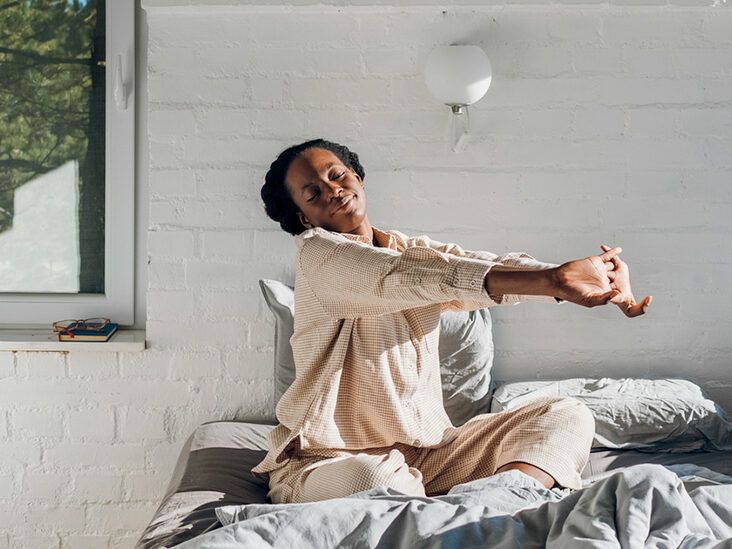The key to yoga for sleep is to stick with calm and restorative poses.
Though it may be tempting to think you should tire yourself out with intense workouts before bed, you actually want to calm your nervous system and wind down from your day.
An
Follow this routine to get started.
Forward Fold is a gentle inversion. It activates your parasympathetic nervous system. This system slows down bodily processes. It will release tension and help you get to sleep.
Muscles Worked: latissimus dorsi, teres minor and major, erector spinae, gluteus maximus, hamstrings
- Begin standing upright with your feet hip-distance apart.
- Take a deep inhale as you raise your arms up and out until they meet above your head.
- As you exhale, pull your knees up by contracting the fronts of your thighs and bend forward from the waist.
- Settle into the stretch by breathing in gently and grasping opposite elbows, letting your arms hang directly beneath your head — widen your stance if you’re at all worried about balance here.
- Take in 10 to 15 slow, deep breaths before you gently rise to stand.
Twists, in general, help detox, release tension, and reduce back pain. Beyond that, it’s been found that certain reclining poses help relax your baroreflex, which helps lower your blood pressure. This can assist in helping you get to and stay asleep.
Muscles Worked: glutes, erector spinae, external obliques
- Lie on your back on the mat. As you inhale, draw your knees into your chest.
- As you exhale, extend your arms out your side at shoulder height and let your knees fall to the side, stacking your knees on top of each other. If you need or want, you can put a small cushion (like a throw
pillow) under your bottom knee to support the twist. - As you breathe into the twist, check in with your body and be sure neither shoulder blade is pulling up off the ground. If it is, you can raise your legs a little and add a cushion (or another cushion) to keep your shoulders pressing into the mat.
- Stay here for at least 5 deep breaths. On an inhale, lift your legs back to your chest, pressing into your arms to help move them, and then drop them to the other side.
Puppy Pose is a modified Child’s Pose. It stretches the upper back, spine, and shoulders. This helps relieve tension and stress. The forehead on the ground also stimulates the pituitary gland, which is a major source of melatonin, which helps you in getting to sleep.
Muscles stretched: latissimus dorsi, teres major, rotator cuff muscles, abdominals, deltoids
- Get into all fours on the mat, keeping your hips stacked over your knees and your shoulders stacked over your wrists.
- Without moving your hips, begin to walk your hands out in front of you, keeping your elbows off the floor.
- As you exhale, tuck your toes under and move your buttocks about halfway to your heels and gently drop your forehead to the mat.
- Breathe here, keeping a slight curve in your lower back, pressing your hands down, and stretching through your arms and spine.
- Stay here for 5 to 10 breaths before walking your hands back so you’re on all fours again.
Child’s Pose stretches the hips, thighs, and ankles. It also passively stretches the back torso and gently relaxes the muscles of your front body. This pose reduces stress, stimulates melatonin, and calms the mind.
Muscles stretched: latissimus dorsi, lower back, shoulders, hips
- From all fours, bring your big toes together so they’re touching, widen your knees to at least hip width, and then sit back on your heels.
- As you exhale, lay your torso between your thighs. If it’s more comfortable, you can widen your feet or lay a long, narrow cushion between your legs to support your torso.
- When you’re lying fully in Child’s Pose, you can have your arms out in front of you, stretching, but as a follow-up to Puppy Pose, you can lay your hands alongside your torso, palms up.
- Stay here for at least 10 breaths. When you rise from it, do so as you inhale and use your hands to support you if you like.
Legs-up-the-wall is a gentle inversion. It’s also completely passive, so it helps prepare your brain and body for sleep.
Muscles stretched: hamstrings and neck, front of the torso
- Move your mat to an area of the wall with space and sit parallel to it.
- Lie down with your feet on the ground, knees bent.
- Resting on your lower back, lift your feet and gently swing your torso so it’s perpendicular to the wall. Place your sitting bones up against the base of the wall and your legs up against the wall. Get comfortable here, moving your torso and inching your lower back closer to the wall if need be. Extend your legs up the wall. (Note: Placing a cushion or folded blanket under your lower back can add to your comfort here.)
- Rest your arms out to your sides at whatever angle feels good, palms up. Stay here as long as you like, breathing deeply and releasing tension.
Doing these exercises before bedtime tonight can provide you with immediate results in the form of a better night’s sleep. Even better news: If you add them to your nighttime routine regularly, the effects will increase, and your sleep will continue to improve.
Gretchen Stelter is a freelance writer and editor based in the Pacific Northwest. With over a decade of experience working with writers, she’s been part of over 400 books published by traditional publishing houses as well as editing for businesses and writing book proposals, nonfiction, YA, and articles for Books for Better Living and Elephant Journal. She spends time she isn’t reading, editing, or writing volunteering for Girls Inc. and teaching yoga in after-school programs. She can be found at gretchenstelter.com as well as on Facebook and Twitter.





